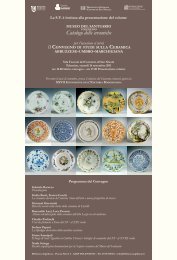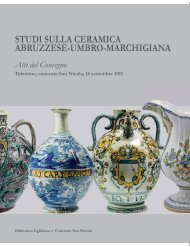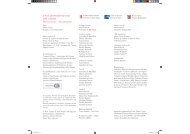Le maioliche rinascimentali nelle collezioni della ... - Claudio Paolinelli
Le maioliche rinascimentali nelle collezioni della ... - Claudio Paolinelli
Le maioliche rinascimentali nelle collezioni della ... - Claudio Paolinelli
Create successful ePaper yourself
Turn your PDF publications into a flip-book with our unique Google optimized e-Paper software.
139 Fluted bowl with oak-leaf ornament (cerquate).<br />
Urbino or its neighbourhood, c1545-1555.<br />
The bowl is decorated with oak-branches on a green ground<br />
and a central medallion with a standing putto. The decoration<br />
is that known as cerquate, much used in the Duchy in homage<br />
to the Della Rovere (meaning “of the Oak tree”) family 1 . The<br />
colours are green, yellow, blue, orange, and brown.<br />
Analysing the composition of the bowl, one may note how the<br />
arrangement of the oak branches corresponds closely to Piccolpasso’s<br />
drawing (reproduced on p. 210 of the first volume of<br />
this catalogue), with four pairs of crossed branches around the<br />
central roundel. The attribution of this type to Castel Durante<br />
is, in the present state of knowledge, more traditional than<br />
demonstrable and is not supported by excavated material 2 .<br />
Manufacture in Urbino seems equally possible 3 ; there is evidence<br />
of production from the 1520s 4 into the second half of<br />
the century 5 . The style of the painting is fluid, but with sound<br />
drawing in the rendering of the veining of leaves and the<br />
substance of the branches.<br />
The bowl cannot easily be associated in its style and colouring<br />
with other pieces 6 , but in the French national museums 7 are<br />
two pieces with cerquate which adopt the same solution of<br />
filling the background with dense green brush-strokes. In particular,<br />
a plate at Sèvres adopts a similar solution by incorporating<br />
at the base of the intersecting oak branches a single leaf<br />
on a dark blue ground. Furthermore the way of painting the<br />
crinkled surface of the leaves with a sort of cross-hatching and<br />
the addition of little curls at the top may suggest the two<br />
pieces were made in the same workshop.<br />
The winged putto in the centre is set in a rudimentary landscape<br />
and drawn with rapid strokes. The almost compendiario<br />
432<br />
(sketchy) style 8 of the figure suggests a dating around the middle<br />
of the sixteenth century. [CP]<br />
The bowl is on a low foot. Tin-glazed front and back. It is mouldmade,<br />
with four concentric arches and sixteen lobes. Compare no. 133.<br />
On the rim, front and back, is a narrow yellow line. Some firing flaws<br />
on the back.<br />
Diam: 28.4 cm.; height 7.7 cm.<br />
There is wear to the edge and chipping to the foot. Some retouching.<br />
Provenance: J.M. Béalu & fils, Paris; Romano Graffi, Bologna; Cesare<br />
Ugolini; Fabrizio Frizzi Baccioni.<br />
Bibliography: Rossi Guzzetti 2002, p. 15.<br />
Notes<br />
1 See p. 210 of Vol. I of this catalogue. “These cerquate are much in use<br />
with us [in the Duchy of Urbino] for the veneration and duty we have<br />
to the Oak Tree (Rovere), in whose shade we live happily; so that it may<br />
be called an Urbino style of painting”. It seems reasonable to think that<br />
the characteristic branches and acorns were used out of respect to the<br />
Ducal family, and not simply as subsidiary decoration, in various applied<br />
arts: Montevecchi 2001, pp. 323-334.<br />
2 Zumstein 1997, p. 87, fig. 87. At present only a single fragment with<br />
cerquate has been found in Castel Durante. It seems also uncommon at<br />
Pesaro (Berardi 1984, p. 196). Six fragments are known from Fano.<br />
3 Wilson 2003D, pp. 157-160: “If the Piccolpasso manuscript was wholly<br />
written and illustrated... around 1557, it is curious that this is one of<br />
several designs that seem to have been old-fashioned when he wrote...,<br />
the conclusion that the Blumka plate and other cerquate... were made in<br />
Urbino, rather than in Castel Durante”.<br />
4 Ivanova 2003, no. 109: the Hermitage example is dated 1526.<br />
5 Fiocco and Gherardi 1997, no. 6.<br />
6 Rackham 1940, nos 597, 598, 604, 605; Hausmann 2002, no. 65.<br />
7 Giacomotti 1974, nos 786, 787.<br />
8 Ravanelli Guidotti 1996C.








